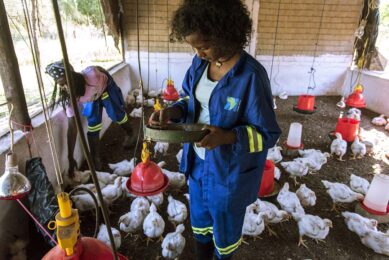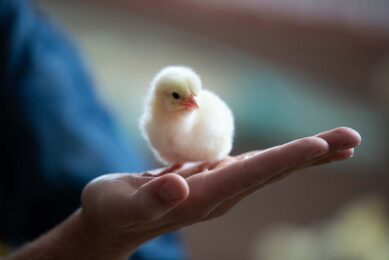Counting the cost of ORT
![Europe produces around 30% of the world s turkey meat and it is in these birds that ORT is considered a problem. [Photo: Marco Vellenga]](https://www.poultryworld.net/app/uploads/2021/04/001_769_rb-image-1726827-848x565.jpeg)
Ornithobacterium rhinotracheale (ORT) is not easily diagnosed and its sensitivity to a number of commonly-used antimicrobials has decreased significantly. The newer generation macrolide ?tylvalosin became the first antimicrobial to be granted an EU marketing authorisation, specifically for the treatment of ORT in turkeys via drinking water.
ORT came to prominence in the mid-1990s when the first strain was identified and named. However, despite its potential economic impact on commercial poultry production, it was only last year that the first antimicrobial in-water treatment was authorised in the EU, specifically for the treatment of ORT in turkeys. A subsequent trial done with Aivlosin Water Soluble Granules in a commercial turkey unit demonstrated great net financial benefit of €3.42 for each bird slaughtered.
ORT is not fully understood or optimally managed by poultry producers in all parts of the world. ORT can infect chickens (where it can cause air-sacculitis), as well as many species of wild birds. A survey of commercial broiler units in Germany found that most flocks had been exposed to infection; in Belgium, the organism was isolated from affected birds on 80% of the flocks monitored when the birds were between 3 and 6 weeks of age. As with many other respiratory infections, ORT may be a primary pathogen or a secondary problem following viral or other challenges, and this can result in lung lesions which may only be apparent at slaughter. Infection may be seen in broilers as early as 3 weeks of age and can result in reduced growth, respiratory signs, lameness and increased mortality. It is even more common in breeders and layers, where it causes a reduction in egg production and size.
Also see World Poultry’s Health Tool – giving the latest insights on the 40+ most common poultry diseases, focusing on causes, clinical signs and proven treatment and control measures to take in account.
ORT in turkeys – a complex health issue
In turkeys however, ORT can produce more obvious respiratory signs, such as nasal exudate, tracheitis, pneumonia and pleurisy in the lower respiratory tract and often evolving to tenosynovitis with lameness and mortality, especially in older male birds. Along with Mycoplasma spp. and other respiratory pathogens, it may contribute to a so-called respiratory disease complex. Several different strains have been identified globally with the A strain being the most prevalent, other strains occur as well.
Europe produces around 30% of the world’s turkey meat and it is in these birds that ORT is considered a problem. ORT is known to spread horizontally from bird to bird within flocks, and its rapid emergence and spread suggests that it may also be transmitted vertically. The financial losses associated with ORT include increased mortality, reduced growth rate, lower feed conversion, lower carcass quality and worsened grading, more condemnations, and the cost of ineffective or inappropriate treatment.
ORT is a slow growing organism that is difficult to grow and isolate in vitro, and diagnosis usually requires a combination of clinical signs. [Photo: Marco Vellenga]
Diagnosis and treatment
ORT is a slow growing organism that is difficult to grow and isolate in vitro, and diagnosis usually requires a combination of clinical signs, post-mortem pathology and ELISA testing as well as isolation of the bacterium itself.
Since ORT was first classified, its sensitivity to a number of commonly-used antimicrobials has decreased significantly. The situation varies from region to region depending on the prevalent strains but few antibiotics are consistently effective against different ORT isolates. A report from Belgium found that many of the 45 isolates, tested for MIC’s (Microbiological Inhibitory Concentration) values in vitro, were resistant to ampicillin, lincomycin, tylosin, tilmicosin, a few strains were sensitive to enrofloxacin and doxycycline. A second similar study of Mexican isolates found that obtained results among the isolates indicate a market antimicrobial drug resistance trend, for strains tested in vitro.
Macrolide tylvalosin
In 2014, the newer generation macrolide tylvalosin, specific Aivlosin Water Soluble Granules from ECO Animal Health, became the first antimicrobial to be granted an EU marketing authorisation, specifically for the treatment of ORT in turkeys via drinking water. This work was supported by results from commercial turkey units which showed that even under conditions of high challenge, operations achieved improved survival rate, average daily gain, feed conversion and fewer rejected birds at slaughter when treated with tylvalosin compared to amoxicillin. Treatment with Aivlosin at 25mg/kg/day for 5 days at six weeks and again at 17 weeks of age was compared to amoxicillin at 10mg/kg/day for 5 days at 6 weeks, which was the existing programme, in over 3,000 turkey poults. The Aivlosin treatment resulted in a 1.23% lower mortality, a 14-g improved average daily gain, and an FCR ratio that was 0.441 better when measured at the end of the whole production period. The number of rejected birds at slaughter were 2.3% lower for the Aivlosin group and 10% more birds made ‘A’ grade at processing.
An analysis of the financial benefits of Aivlosin in the trial revealed a net benefit (after cost of treatment) of €3,42 for each bird slaughtered. The performance benefits associated with Aivlosin have prompted ECO Animal Health to develop a production economics calculator that allows individual poultry businesses to calculate their potential savings from using Aivlosin based on the individual parameters from their own operation.
Have you seen: Turkey diseases requiring antimicrobial control
Antibiotics in animal production have been under fire in recent years for reasons of public health. Particularly the EU is taking the lead in this respect. Their use must be limited. Despite proper management and biosecurity measures however, certain diseases and syndromes like in turkeys need antimicrobial control.
Part of the effectiveness of Aivlosin may be explained by tylvalosin’s enhanced lipid solubility which allows it to concentrate rapidly in lung tissues and bronchial fluids. The pharmacokinetic and dynamic profile of tylvalosin is highlighted by a study in 8-week old chickens given 20mg/kg/day in drinking water either continuously or daily. Aivlosin is compatible with in-feed ionophore anti-coccidials approved for use in turkeys, and has no activity against Salmonella species, so there is no interference with Salmonella monitoring programmes.
Vulnerable around 4-6 weeks
Turkeys are most vulnerable to ORT at around 4 to 6 weeks of age which often corresponds to a move into the growing house. This is when maternal immunity is at its lowest and individuals are most vulnerable to infection. It is important to treat birds before they succumb to secondary respiratory infections and are very likely irreversibly damaged. The exact timing of ORT treatment will depend on the timing of ORT risk within individual units, and it is important to target treatment after careful diagnosis and consideration of the farm’s disease history. It may be appropriate to treat day-old poults and/or during the growing phase; in both cases Aivlosin Water Soluble Granules are administered in the drinking water at a rate of 25 mg tylvalosin/kg bodyweight for 5 days. Aivlosin is only available on veterinary prescription.
ORT is undoubtedly a serious disease with significant economic consequences for turkey producers. With apparent increasing value of MIC’s (minimum inhibitory concentration) to many conventional antibiotic treatments, the development and authorisation of Aivlosin in the EU, has provided an effective tool for countering the economic impact of this pathogen.
Join 31,000+ subscribers
Subscribe to our newsletter to stay updated about all the need-to-know content in the poultry sector, three times a week. Beheer
Beheer








 WP Admin
WP Admin  Bewerk bericht
Bewerk bericht